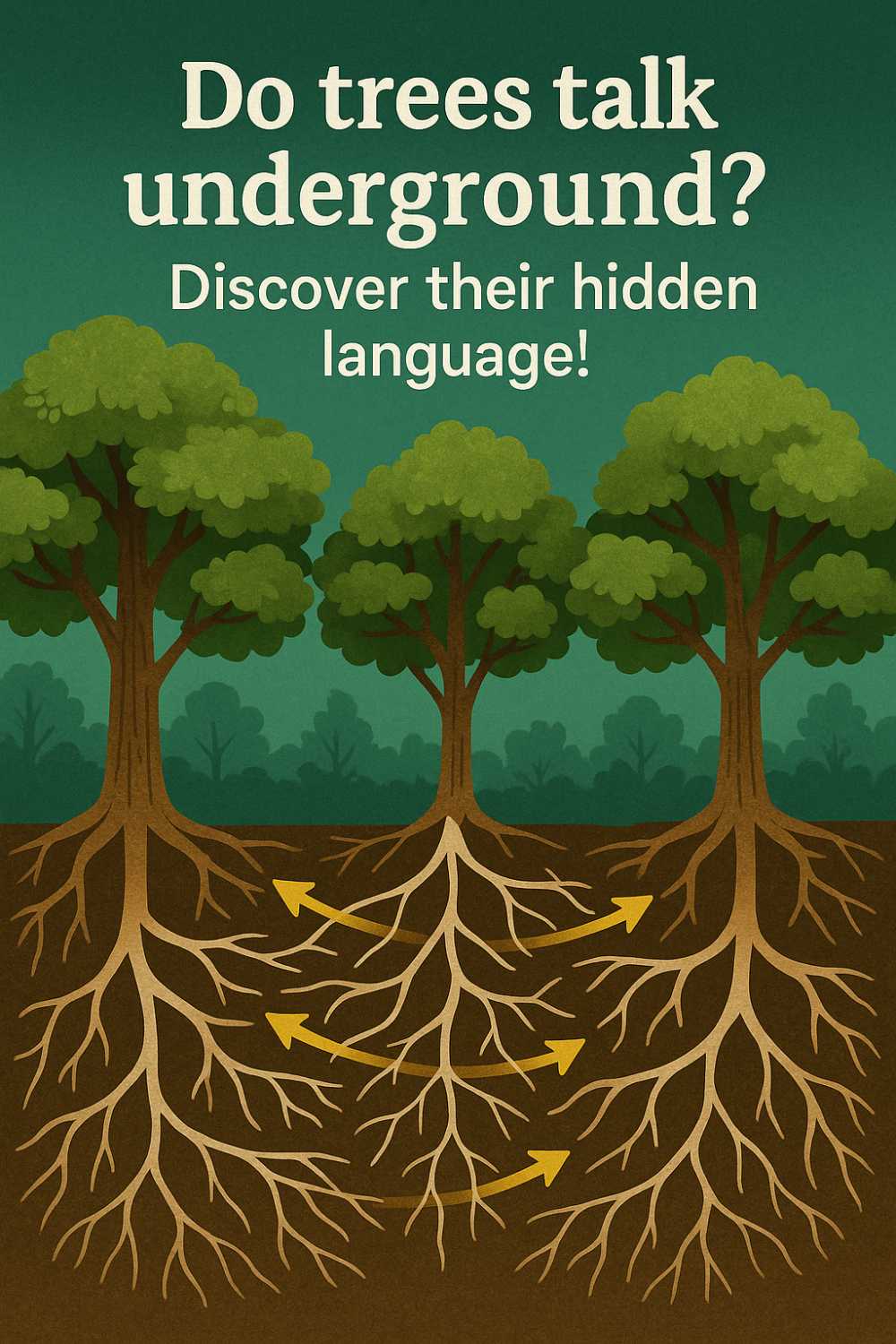
If you’ve ever walked through a quiet forest and felt like something was going on under your feet, you’re not wrong. The ground looks still. It isn’t. Roots, fungi, bacteria—there’s a lively exchange happening down there. So, do trees secretly communicate through roots? Short answer: yes, in their own plant-ish way. Not with words or whispers, but with signals, trade, and some sneaky resource shuffling that would impress any neighborhood watch.
Let’s dig into what’s actually known, what’s hype, and how this “tree talk” shows up in the real world.
The Underground Network That Makes It All Possible
Picture power lines and data cables running to every house on a block. Now swap wires for fungal threads. Trees team up with fungi in a partnership called mycorrhiza. The fungi wrap around or slip inside tiny root tips and extend outward like hair-thin highways. These networks connect multiple plants at once, sometimes across big patches of forest. Scientists call these webs common mycorrhizal networks (CMNs).
Why would a fungus do this? Food. Fungi can’t photosynthesize, so they take sugars from trees. In return, they fetch water and nutrients—phosphorus, nitrogen, micronutrients—from soil that roots alone struggle to reach. The bonus feature: the network doubles as a messaging system.
What Counts as “Communication” for a Tree?
Trees don’t text. They don’t gossip. Their communication looks more like this:
Chemical notes: Roots release compounds that fungi can ferry to neighbors. Think alarm cues and status updates.
Hydraulic shifts: When water pressure changes in one plant, connected partners can sense it fast.
Electrical blips: Plants generate tiny voltage changes. Not the stuff of spy movies, but enough to trigger responses.
If “communication” means one organism sends a signal that changes the behavior or state of another—yep, trees do that.
The Famous Question: Do Trees Feed Each Other?
You’ve probably heard the story: old trees act like parents, passing carbon to younger trees. Some of that is true, some gets oversold. Using carbon isotopes as tracers, researchers have documented carbon transfer between connected plants. This happens via shared fungi or, in some cases, root grafts—literal fusions where roots join and share sap.
But scale matters. Transfers are usually small in the big picture of a tree’s budget. Helpful in tough times? Likely. A magical welfare network where the forest’s wealthy keep everyone flush? Not quite.
The “Wood Wide Web” Is Real… and Messy
The headline version says forests are wired like the internet. The reality is patchier. Networks exist, break, reform, vary by species, soil, season, and history. Some trees are well-connected hubs. Others sit on the edge of the network with fewer links. In mixed forests, not every tree species plugs into the same fungal provider. It’s less a clean, citywide grid and more a bunch of overlapping Wi-Fi networks, some with lousy passwords.
Warnings, Alerts, and Plant Drama
When a plant gets chewed, it pushes out warning signals. Aboveground, leaves release scents that cue neighbors to armor up. Belowground, root-to-root or fungus-mediated signals can boost defenses in nearby plants—more bitter compounds, tougher cell walls, different enzyme mixes. Trees aren’t plotting revenge; they’re flipping switches in chemistry labs built into their cells.
This doesn’t mean altruism. If everybody’s a little harder to eat tomorrow, the hungry insect moves on. That’s good for the group. The motivation, though, is baked by evolution, not morals.
Root Grafts: The Stranger Trick
Sometimes roots of the same species physically fuse. You can find living stumps—no leaves, no photosynthesis—kept alive by neighbors. They run on shared sap through grafted roots, like a tree on life support. It’s weird, a little spooky, and absolutely real. Communication here is brute-force: shared plumbing, not subtle signaling.
How Fast Is This Underground Chatter?
Faster than you’d think for a tree, slower than your phone. Hydraulic cues can move quickly. Chemicals move slower. Electrical pulses are quick but still have to trigger biochemical changes, which take time. It’s not a ping. It’s more like a pulse that says, “Tighten up; something’s off.”
Is “Mother Tree” a Thing?
The phrase is catchy. Big trees do influence the little ones. They can shade, shelter, and sometimes feed. Their roots and fungal partners reshape the soil. But calling them “mothers” turns complex ecology into a family drama that’s a bit too tidy. Some scientists love the metaphor. Others roll their eyes. The safe middle: older, larger trees often act as structural and ecological anchors. They matter. They’re not writing bedtime stories.
The Skeptics Have Good Points
Not every forest runs on a kind, orderly network. Sometimes the competition is fierce. Trees can hog light and nutrients. Signals can benefit the sender more than the receiver. Measured carbon transfers are often tiny. Experiments in pots don’t always match field results. The underground is hard to study, which means results come with caveats.
So, if you see someone online claiming forests behave like small villages with perfect sharing rules, take a breath. The truth is more interesting than myth. It’s cooperation and competition, side by side, changing with weather, soil, species, and time.
What “Do Trees Secretly Communicate Through Roots?” Means for Your Yard
You don’t need to move to a primeval forest to care. Even in backyards and city streets, roots talk, trade, and tangle.
Disturbed soil = broken phone lines. Construction, tilling, and heavy foot traffic can tear up fungal threads.
Mulch helps. Wood chips and leaf litter protect fungi, keep moisture, and feed the system.
Fungicides nuke the network. Some are necessary, but blanket use shuts down the good guys too.
Diversity is fuel. A mix of plant species supports a richer fungal community and more stable networks.
Choose partners. Many trees love mycorrhiza. Pair them with understory plants that play nice with fungi.
City Trees: Can They “Talk” Too?
Urban life is tough on tree communication. Small pits, heat, salt, compacted soil—none of it screams “thriving network.” Still, where soil volume is decent and mulch is thick, mycorrhiza build back. Neighboring trees in continuous soil can connect. Street blocks with shared planting strips do better than lonely trees marooned in concrete.
Signals Aren’t the Only Story
Roots also reshape the soil to favor their own kin. They leak sugars (root exudates) that feed specific microbes, which in turn help with nutrients or defense. This creates microbial neighborhoods that bias the odds for certain plants. Is that communication? Not in the chatty sense. It’s more like tuning the room so your instrument sounds better.
Eavesdropping and Manipulation
If signals exist, freeloaders will follow. Some plants plug into networks and take more than they give. Some fungi tax their hosts hard. A few pathogens hack the system, riding highways meant for helpful fungi. That’s the trade-off with any shared infrastructure. Highways move ambulances and robbers.
So… Do Trees Secretly Communicate Through Roots?
They do—just not with secrets and not always the way the headlines suggest. Trees signal. They share resources. They coordinate defenses. They do it through a patchy, living network of roots and fungi that changes by the week. Sometimes it looks generous. Sometimes it’s cutthroat. Either way, it’s communication in a plant world that runs on molecules, water pressure, and quiet chemistry.
How We Know Without Digging Up the Whole Forest
Researchers tag carbon with special isotopes, let a tree absorb it, then check neighbors for traces. They set up barriers that block roots but not fungi, or block fungi but not roots, to see what gets through. They measure plant hormones and defense chemicals before and after a neighbor is stressed. They record electrical shifts. It’s hard, slow work. The results point to a network that’s real—and more complicated than any slogan.
A Quick FAQ You Didn’t Ask For (But Might Be Glad You Read)
Is every tree connected to every other tree?
No. Networks form clusters. Species, soil type, and fungal partners sort who links with whom.
Can a tree “choose” who to help?
“Choose” is a stretch, but trees and fungi have biases. Related trees and familiar fungal partners often get better deals. Signals sometimes travel preferentially along certain links.
Do networks make forests healthier?
Often, yes. Better nutrient access, shared warnings, and improved drought tolerance can stabilize a stand. Not a silver bullet. Still a big deal.
Can I boost this in my garden?
Yes. Minimize soil disturbance, keep a mulch layer, avoid broad fungicides, grow a mix of plants, and water deeply rather than often.
Are root grafts common?
Common enough to matter, especially within the same species. They’re natural splices that move water, sugars, and minerals.
If the network is so helpful, why do some trees still die?
Because drought, pests, disease, poor soil, heat, and human pressure can overwhelm any support system. The network softens blows. It doesn’t make trees invincible.
The Bottom Line
“Do Trees Secretly Communicate Through Roots?” isn’t a fairy tale. It’s biology with flair. Trees and fungi build underground webs where messages and meals move around. The system isn’t always kind. It isn’t always fair. It is always busy. And the next time you’re in the woods, that quiet you hear? It’s full of conversation you can’t hear—signals sliding through threads, roots flexing, chemistry humming along. The forest looks still. It’s anything but.

